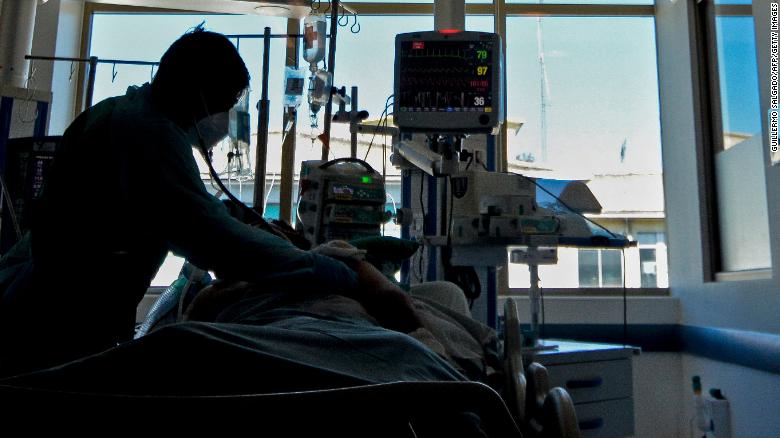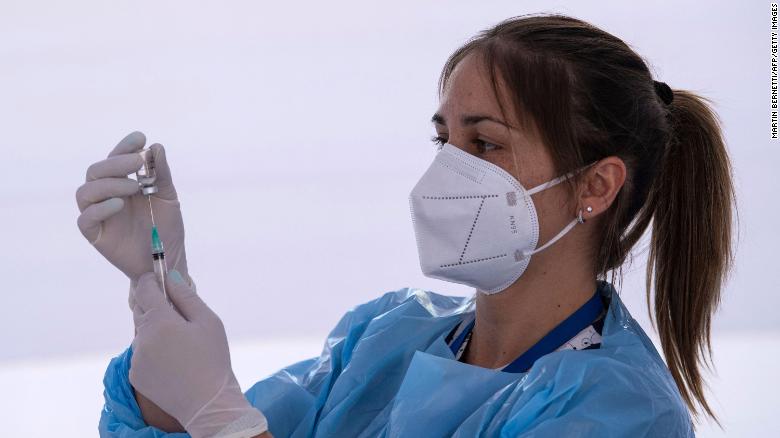It was supposed to be Latin America’s bright spot in the fight against Covid-19.
Chile, a country of 19 million on the Pacific coast of South America, had gotten a head start on vaccines by making agreements with pharmaceutical companies only months into the pandemic. By the beginning of this year, Chile had reached one of the highest vaccination rates in the world, while other countries in the region had yet to get any vaccines.
As of Wednesday, Chile had a vaccination rate of 38.94 per 100 people, only behind Israel (61.58) and the United Kingdom (47.51). In terms of vaccination, it is ahead of the United States (36.13), according to data published by Oxford University’s “Our World in Data” database.
Yet the pandemic has hardly abated. Last week, Chile broke records on its number of daily cases since the start of the pandemic on two consecutive days: 8,195 new Covid-19 cases on Thursday and 9,171 on Friday. And even though the number of new cases diagnose per day has fallen this week, the reality is that a spike that began in December has continued steadily in Chile.
As of Wednesday, Chile was approaching 1.1 million total Covid-19 cases. Nearly 25,000 people had died of the disease, according to data from Johns Hopkins University. What went wrong?

Health authorities, experts and journalists consulted by CNN say the world can learn a lot from a multi-factor, “perfect storm” that hit Chile starting with Christmas gatherings and New Year’s festivities, a sustained push to reopen all schools and shopping malls, an anticipated sense of safety given the rapid pace of vaccinations and less-than-desired levels of effectiveness of the Sinovac vaccine, which has been widely used in the country.
Francisco Álvarez, a public health expert and, until recently, the health department director in Valparaíso province, the second-most populated in Chile, says that relaxing Covid-19 restrictions around the end-of-year holidays started it all.
“Just before Christmas, we would see whole families going shopping for presents and there would be crowds at shopping malls. Starting in January, people were allowed to travel between provinces to go on vacation and the virus traveled with them,” Álvarez said. January is summertime in the Southern Hemisphere and, in Chile, it’s typically high season for domestic and international travel.
Álvarez, who had his own bout with Covid-19 last summer and spent weeks in the hospital, also said there would be crowds at beaches in Valparaíso province, a top tourist destination and even though his office organized mobile testing sites, people would refuse to get tested because “they didn’t want to be bothered while on holiday.”
“People got two misleading messages: you can go on vacation anywhere in the country or abroad and we’re one of the top countries in Latin America in terms of vaccination. People understood that the risk of contracting the virus was probably over and relaxed measures. That created the perfect storm,” Álvarez said. He added that there were also many Chileans who traveled to Europe and other countries with a high incidence of cases, which contributed to the spike.
While at his former post in Valparaíso’s health department, Álvarez’s office documented 60 infections of mainly young people who had attended the same New Year’s Eve clandestine party, when such gatherings were still prohibited.
The establishment where the party was held was fined the equivalent of about $71,000. A young man who failed to quarantine after testing positive to Covid-19 was fined the equivalent of about $35,000.
There were at least six clandestine parties attended mainly by young people visiting from Santiago, the capital. That produced Covid-19 spikes in a region that had until then had a relative low number of cases. Infections among local people began to increase as well.

Authorities were forced once again take drastic measures to fight the pandemic. Schools that had been reopened for in-person classes were once again shut down. Only essential businesses like supermarkets were allowed to remain open. Thirteen million Chileans across the country were again put on lockdown in late March, although enforcement was lax, and CNN could still see plenty of people on the streets of the capital.
On Tuesday, Health Minister Enrique Paris said that, while it’s true some measures were relaxed in December, he never told people to stop following preventive measures. “We’ve been on quarantine in the metropolitan region for 14 days and we’re seeing good results together with our vaccination efforts.”
“We never said vaccination was going to be the only answer. We have to vaccinate, but we also have to remain mindful of other things like reduced mobility, wearing masks, washing our hands and social distancing so that the virus doesn’t get disseminated,” Paris said.
And then there’s the issue of the vaccine itself. Chile has been successful in widespread vaccinations in part because its government went after any vaccine it could get. But the widely-used CoronaVac vaccine developed by Sinovac, a private company, was found to have an efficacy rate of just 50.4% in clinical trials in Brazil. Another trial in Turkey showed it was 83.5% effective. State-owned Sinopharm said its two vaccines have efficacy rates of 79.4% and 72.5%.
Although it’s too early to say whether that contributed significantly to the spike in cases, high-profile cases in Chile of people who were vaccinated and still ended up in the hospital with the disease have stirred anxiety in the country.
Celestino Aos, archbishop of Santiago, was hospitalized Saturday after testing positive to Covid-19, according to Fr. Andrés Moro, spokesman for the Santiago Archdiocese. Aos was released from the hospital Tuesday. Monsignor Alberto Lorenzelli, auxiliary bishop of Santiago who lives with the archbishop, also contracted the virus, Moro said. Both received the Coronavac vaccine.
Gao Fu, director of the Chinese Center for Disease Control and Prevention has acknowledged the less-than-ideal efficacy rate of Chinese Covid-19 vaccines, telling a conference in Chengdu on Saturday that “the protection rates of existing vaccines are not high.”
Nevertheless, the Coronavac vaccine is thought to be more effective in severe cases.
Researchers from Brazil’s Instituto Butantan earlier this year confirmed the Coronavac’s low overall efficacy, but found the vaccine to be 78% effective in combating mild cases, and 100% effective for moderate and severe cases.
Izkia Siches, who heads “Colegio Médico”, the biggest medical association in Chile, has been critical of the government’s response to the pandemic, saying allowing people to travel during the holidays, mixed messages from the top and lack of resources in local clinics compounded the problem.
After a glowing assessment by Minister Paris during an appearance in the Chilean Congress regarding Chile’s vaccination campaign, Siches fired back, saying “we shouldn’t be self-indulgent. Our country is going through a fragile period right now,” CNN affiliate CNN Chile reported.
Paris, who has been in his post since June, later recognized that Chile “has made mistakes that have probably caused pain for many families. I ask for your forgiveness. We have done everything possible to do things the best way possible.”
As reported by CNN
